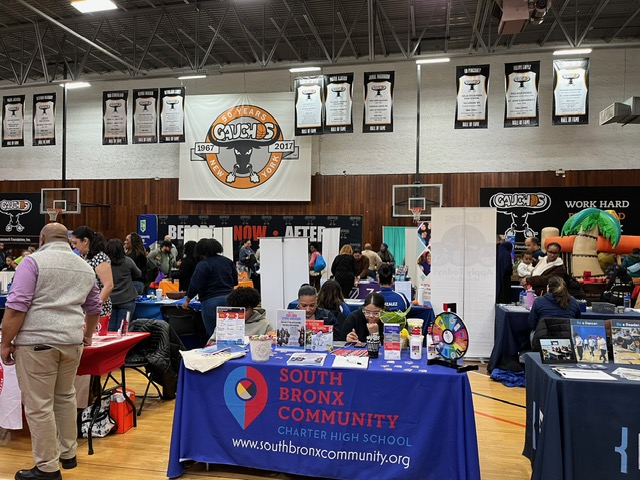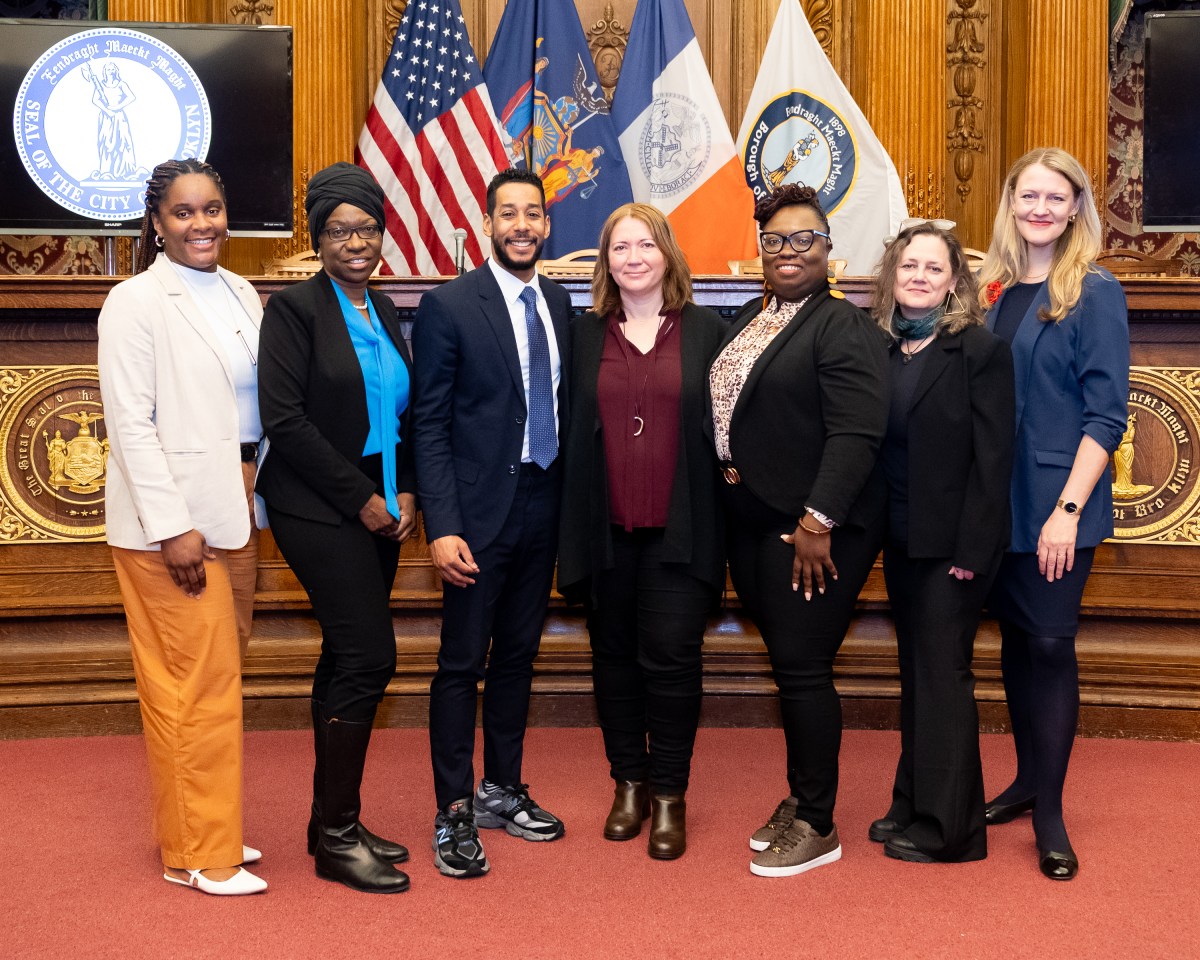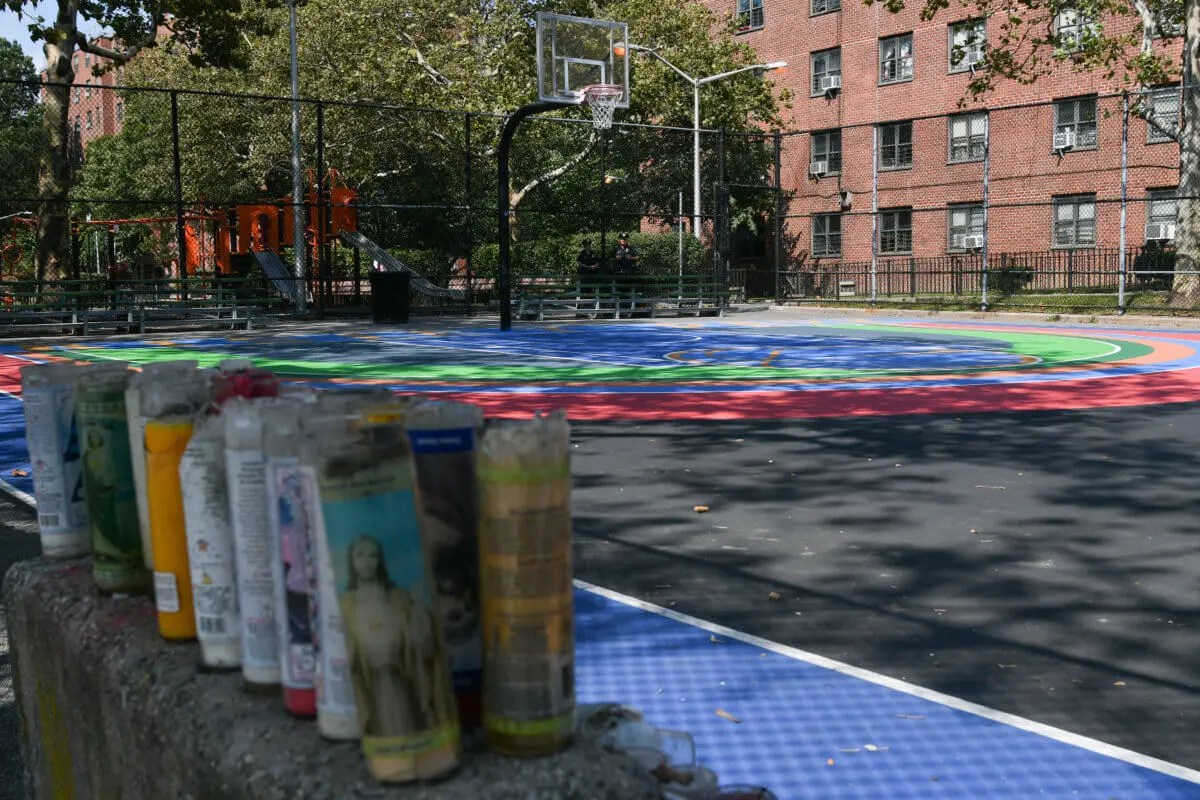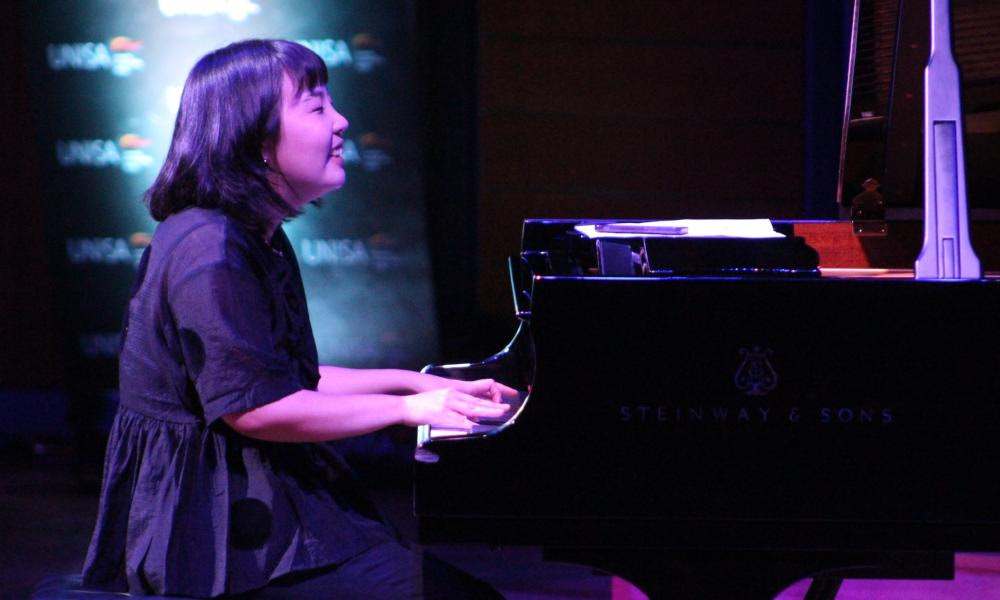
Shino Tanikawa held up a design rendering of the exterior of 75 Morton St., showing how its windows will be enlarged.
BY SARA HENDRICKSON | At a public meeting on Mon., May 11, at the L.G.B.T. Center to “unveil” the Village’s new middle school at 75 Morton St., the crowd of 150 people had a few anxious questions, but most of all, the mood was gleeful celebration that the school would finally open its doors in fall 2017.
The 75 Morton success story of community activism is well known by now. It’s been a 10-year slog by parents and community leaders to pressure city and state officials to provide a desperately needed middle school in the Village. The tireless group identified the Morton St. building — which was partially occupied by a state agency that was being relocated — and convinced local politicians to champion the cause.
David Gruber, former chairperson of Community Board 2, offered glowing opening remarks.
“Our challenge was to get the building out of the state’s grip and to land the plane,” he said. “Mission accomplished.”
City Councilmember Corey Johnson, who represents District 3, applauded the efforts of Assemblymember Deborah Glick and state Senator Brad Hoylman in pushing for the school, noting it was “bittersweet that they are fighting the good fight in Albany and cannot be present tonight.”

Obviously a pretty gifted student, a prospective 75 Morton St. pupil was busy attempting anagrams while simultaneously doing homework during the meeting, above. Jeannine Kiely displayed a poster board with a design of the school’s spacious cafeteria, below.
Johnson pushed hard for the school to have a student health center, which will be located on the basement level. Primary care, dental, vision and mental health services will be offered to students.
Melanie La Rocca, chief of staff of the School Construction Authority and it’s C.E.O. Lorraine Grillo presented a series of poster boards showing floor-by-floor architectural renderings for the school.
For starters, all of the seven-story building’s windows — which were on the small side — will be enlarged to allow in lots of natural light.
The first floor will feature a large lobby and very spacious cafeteria with extra-large windows.
The second floor will be dedicated to the 100 or so District 75 students with special needs, such as autistic spectrum disorder. The fourth floor will feature a spacious library with oversized windows to allow natural light to stream in. Multiple specialty rooms dedicated to music, art and science labs will fill the fifth and sixth floors.
Adjacent to the “L”-shaped building will be a street-level outdoor play area on Greenwich St.
There will also be a “gymatorium” — a regulation-sized gym convertible to an auditorium/theater. The space will feature retractable tiered and floor seating for an audience in “the low 500’s” according to La Rocca.
Advocates are hoping there will also be a “green” rooftop area for gardening and hands-on science projects, although parent fundraising would be needed to build out this area.
The DeMatteis Construction Corporation is the contractor for the ambitious renovation project.
Following the presentation, during the Q&A, some parents pined for a separate gym and auditorium. La Rocca said that, in recent years, all schools built by the S.C.A. for the Department of Education have had gymatoriums, since D.O.E. believes these provide maximum flexibility for a variety of events, from basketball games, to black-box theatre, to full-scale theater productions. The gymatorium can also be divided in two with a temporary partition at half-court.
Before the presentation, Jeannine Kiely, chairperson of the Community Board 2 Schools and Education Committee, made a recruiting push for parents to join the 75 Morton Community Alliance, to provide input on the new school process before the middle school admissions season begins in fall 2016.
The alliance is a coalition of parents from School District 2 elementary schools that has been a key player in the school’s planning, working in tandem with C.B. 2 and Community Education Council for District 2. Between now and next fall, the alliance will host two or three “envisioning meetings” — as it has done during the last two years of planning for the school. The goal will be to gather parent input on critical issues, such as admissions criteria, desired qualities of the principal, and programming for both the middle school and District 75 schools.
“We need representatives from every District 2 elementary school to participate,” Kiely said. “We don’t want just the loudest voices to be heard.”
One of the key items for the school’s successful launch is hiring a principal before the fall 2016 admissions season. That’s when parents want to meet principals face to face and learn first-hand about academics, educational philosophy, programming, extra-curriculars, teaching styles and the ethos of the school. D.O.E.’s current plan has a principal starting date of January 2017, which local parents feel is too late.
Tours of the 75 Morton building won’t be possible, since a temporary certificate of occupancy allowing visitors is not issued until about three months prior opening day. So, parents and school advocates feel, it is important for a principal to be in place to embody the school’s mission for prospective families. In place of an on-site school tour, the hope is that, with the help of a tech-savvy parent volunteer, a virtual building tour could be created online to tout the new school’s state-of-the-art facilities.
One of the hot topics parents will want input on is admissions criteria. As C.E.C. President Shino Tanikawa explained, there are several middle school admissions processes. These range from “unscreened,” in which any student can apply without being evaluated; to “screened,” where a variety of metrics, such as grades, writing samples, interviews and test scores, are used to make admissions decisions — although many middle schools do not take standardized test scores into consideration. There are even a handful of zoned middle schools in District 2, such as Baruch and Wagner, for which admission is simply based on home address.
According to Tanikawa, D.O.E. has historically controlled admissions policies for new schools — not allowing parental input into the process. But the C.E.C. has been studying various approaches to middle school admissions and is pushing D.O.E. to allow it to have an advisory role to institute changes. Given the shortage of school seats in District 2, the maze of middle school admissions has only exacerbated the stress felt by families of fifth graders.
The number of students that will attend the 75 Morton school is also up in the air. Although the S.C.A. says it designed a school with a 900-student capacity, D.O.E., not the S.C.A. will dictate enrollment. But that won’t be without input from C.B. 2, C.E.C. and parents, insisted Kiely.
“The D.O.E. knows where we stand,” she said. “We don’t want a sardine model. We want a ‘right-sized school’ of 600 to 700 students.”
Kiely anticipated that the school will open with a sixth grade and add a grade each year, although D.O.E. approval of the rollout has not yet been finalized.
The successful collaboration between the community and D.O.E. is expected to continue, as the agency has committed to bimonthly calls with representatives from C.B. 2, C.E.C. and the 75 Morton Community Alliance. Thankfully, the S.C.A. has a stellar track record of building best-in-class new schools and meeting scheduled opening dates, so these deliberations can focus less on construction progress and more on the next big questions. Who will lead the school as principal? What kinds of academic and enrichment programs will be offered? How best to fill the school with a diverse mix of students from across District 2?
P.S. 3 parent David Colby, who has a daughter in third grade who would join the inaugural 75 Morton class of sixth graders, said he is “really motivated.”
“At P.S. 3, parents helped design our school’s unique curriculum and didn’t have to answer much to the Board of Ed,” he said. “So if we mobilize for 75 Morton, maybe we can avoid the morass of testing and flawed admissions and create an amazing school.”
At one point during the meeting, it was asked how many in the room were the parents of current third graders, and about half of those present raised their hands.
 Advocates stressed that now is the time for parents to step up and have a voice in shaping 75 Morton into a top-notch middle school. Parents can get involved by contacting the 75 Morton Community Alliance at HYPERLINK “mailto:75morton@gmail.com” 75morton@gmail.com.
Advocates stressed that now is the time for parents to step up and have a voice in shaping 75 Morton into a top-notch middle school. Parents can get involved by contacting the 75 Morton Community Alliance at HYPERLINK “mailto:75morton@gmail.com” 75morton@gmail.com.
The kickoff to plan the envisioning meetings during the next school year will take place on Mon., June 1, at 6:30 p.m. at P.S. 33, 281 Ninth Ave. (between W. 26th and 28th Sts.).
“The incredible designs we’ve seen today came from unprecedented communication between the D.O.E., parents, community and elected officials,” Kiely told the crowd. “If we work together and continue to give the D.O.E. our input on admissions, programming, partnerships and more, just think of what we can create!”
Looking at the design renderings after the meeting, Nadine Hoffmann, president of the Village Independent Democrats, remarked, “I wish I had a young kid to go to this school. My kid went to LAB School. It was a wonderful school — but the physical plant, it looked like a jail from the outside.”
Terri Cude, first vice chairperson of C.B. 2 said, “Of all the issues we deal with on the community board — all the victories, the defeats — this is a real win.”
Tony Hoffmann, Nadine’s husband, said, “They fought so hard and so long for this. It’s such an example of community action. What I love about it, is that only in the Village can they fight for these details — and get them.”
With reporting by Lincoln Anderson

































